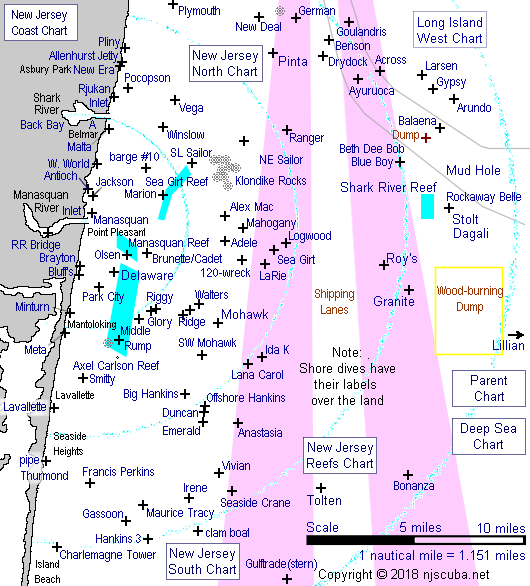Manasquan River Railroad Bridge

- Type:
- inland tidal river
- Depth:
- 20 ft, mostly a lot shallower
This spot is upstream on the Manasquan River. The diving area is rather small and not very deep. Visibility tends to be poor, and this is worsened whenever an O/W training class is in session, which is often. Also, the current under the bridge becomes very strong, so slack water is essential. For a long time, a dredge barge has been anchored in the channel, but otherwise, there is no boat traffic.





Except for small patches of sand, the entire area is completely encrusted with small mussels. The sheer diversity of sea life here is amazing, no lobsters, but in one dive you may see over a dozen types of fishes including tropicals late in the season, large crabs of several types, and various invertebrates. One night I ran into a large Striped Bass right under the bridge. It showed very little fear and hung around for a while, almost in arms reach. I am told that if you swim under the bridge you can find seahorses in the eelgrass on the other side and that in the winter the visibility improves considerably. You can also find old bottles under the bridge, and a buddy of mine once found a .50 caliber cartridge. I wonder how that got there.
One of the most unusual things I have seen at the railroad bridge is a school of squid. They were in waist-deep water, about six inches long and purple. I was wading at the time, in October, and they seemed to be attracted to my light. All kinds of strange things seem to turn up in the fall.


Parking is close by and free, but the lot is not very large and sometimes fills up. A 7-11 store is across the road, and a number of dive boats make their home port nearby. For a unique scuba diving experience, try being under the bridge when a train goes by!
Restrictions:
- Flag required.
- That's it !
Since this is a tidal river, you must dive at slack water. If you've never dived a local river or inlet before, you may want to look at the page on Local Diving Conditions. Diving at slack low tide is not an option - there is not enough water!

Tide predictions for this site are woefully bad. Arrive early, and watch the water for slack tide before going in. Dive your wristwatch instead of your brain, and the current will spit you right through to the other side, where you can spend half an hour clinging to a piling in the marina.
Since the new bridge was built, this place is just not the same. There are much better sites, without the hassle.












Questions or Inquiries?
Just want to say Hello? Sign the .